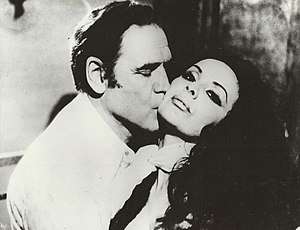Sexploitation film
A sexploitation film (or "sex-exploitation film") is a class of independently produced, low-budget[4] feature film that is generally associated with the 1960s[5] and early 1970s, and that serves largely as a vehicle for the exhibition of non-explicit sexual situations and gratuitous nudity. The genre is a subgenre of exploitation films. Sexploitation films were generally exhibited in urban grindhouse theatres, the precursor to the adult movie theaters of the 1970s and 1980s that featured hardcore pornography content. The term soft-core is often used to designate non-explicit sexploitation films after the general legalisation of hardcore content. Nudist films are often considered to be subgenres of the sex-exploitation genre as well. "Nudie" films and "Nudie-cuties" are associated genres.[5]

History
Following a series of United States Supreme Court rulings in the late 1950s and 1960s, increasingly explicit sex films were distributed.[5] In 1957, Roth v. United States established that sex and obscenity were not synonymous.[5] The genre first emerged in the U.S. around 1960.[6]
There were initially three broad types: "nudie cuties" such as The Immoral Mr. Teas (1959), films set in nudist camps like Daughter of the Sun (1962) and somewhat more "artistic" foreign pictures, such as The Twilight Girls (1961).[4] Nudie cuties were popular in the early 1960s, and were a progression from the nudist camp films of the 1950s.[7] The Supreme Court had previously ruled that films set in nudist camps were exempt from the general ban on film nudity, as they were deemed to be educational.[7] In the early 1960s, films that purported to be documentaries and were thus "educational" enabled sexploitation producers to evade the censors.[8]
Nudie cuties were soon supplanted by "roughies," which commonly featured male violence against women, including kidnapping, rape and murder.[9][10] Lorna (1964) by Russ Meyer is widely considered to be the first roughie.[10] Herschell Gordon Lewis and David F. Friedman's Scum of the Earth! (1963) is another film that is cited as among the first in this genre.[11] Other notable roughie directors include Doris Wishman.[10]
Sexploitation films initially played in grindhouse theatres[12] and struggling independent theaters; however, by the end of the decade they were playing in established cinema chains.[4] As the genre developed during the 1960s films began showing scenes of simulated sex.[13] The films were opposed by religious groups and by the MPAA, which was concerned that sexploitation films were cutting into the profits of major film distributors.[14] Customers who attended screenings of sexploitation films were often characterised by the mainstream media as deviant, "dirty old men" and "raincoaters."[6]
In the mid-1960s some newspapers began banning advertisements for the films.[15] By the late 1960s the films were attracting a larger and broader audience, however, including couples rather than the single males who originally made up the vast majority of patrons.[14] The genre rapidly declined in the early 1970s due to advertising bans, the closure of many grindhouses and drive-in theaters and the growth of hardcore pornography in the "Golden Age of Porn."[12]
White coaters
In the late 1960s, American obscenity laws were tested by the Swedish film I Am Curious (Yellow).[5] After the 1969 ruling by the Supreme Court that the film was not obscene[16][17] because of its educational context, the late 1960s and early 1970s saw a number of sexploitation films produced following this same format. These were widely referred to as "white coaters," because, in these films, a doctor dressed in a white coat would give an introduction to the graphic content that followed, qualifying the film as "educational." The ruling led to a surge in the production of sex films.[5] Language of Love and other Swedish and American films capitalised on this idea until the laws were relaxed.[18]
Notable sexploitation directors
See also
Notes
- Intellect Books (2007). Film Studies. ISSN 2053-5066. Retrieved 20 October 2013.
- Parish, James Robert; Stanke, Don E. (1975). The Glamour Girls. Arlington House. p. 463. ISBN 978-0870002441. Retrieved 20 October 2013.
- Turan, Kenneth; Zito, Stephen F. (1975). Sinema: American Pornographic Films and the People Who Make Them. New American Library. p. 66. ISBN 978-0275507701. Retrieved 20 October 2013.
- Sconce, p. 20
- Weitzer, Ronald John (2000). Sex for Sale: Prostitution, Pornography, and the Sex Industry. Routledge. p. 51. ISBN 0-415-92295-X.
- Sconce, p. 19
- Sconce, p. 49
- Sconce, p. 60
- Sconce, p.50
- Sconce, p. 52
- "The Defilers/Scum of the Earth (1965/1963)". www.digitallyobsessed.com. 2001-02-25. Retrieved 2010-01-04.
- Sconce, p. 42
- Sconce, p. 28
- Sconce, p. 35
- Sconce, p. 36
- Supreme Court of the United States (Byrne v. Karalexis, 396 U.S. 976 (1969) and 401 U.S. 216 (1971))
- "Film International". filmint.nu. Retrieved 16 January 2016.
- Harris, Will (2005-08-31). "Harry Reems Interview: Harry Reems Lays It on the Table". Bullz-Eye.com.
- Sconce, p. 10
- Sconce, p. 24
- Sconce, p. 22
References
- Sconce, Jeffrey (2007). Sleaze Artists: Cinema at the Margins of Taste, Style, and Politics. Duke University Press. ISBN 0-8223-3964-1.
Further reading
External links
| Wikimedia Commons has media related to Sexploitation. |